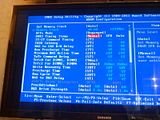That is not bad at all Dave; but what is the last number in the list? I haven't overclocked mine but it was detected wrong and so I set 8,8,8,24 all of which I just about understand, but there is a whole lot of other numbers and the next one is 40, I don't know what that stands for and the advice from Crucial was only to set the first four.
What would happen if I changed the 40?
If I understand your question right, in my previous post the last number represents ROW CYCLE TIME (mine is set at 28).
I'll try and post a picture here.

This is a clickable thumbnail.
Just to give you an idea about how sensitive OC timings are...
If I change RAS# to CAS# delay (tRCD) to a value of 7, I get a BSOD during OS loading,
BUT, this setting works fine with no errors (at least so far).
So sometimes a single change of value can make all the difference.
Whats cool about the BIOS in this instance is the three rows of information that
show actual settings, SPD and AUTO settings! This saves me time and I applaud the fellow
who came up with this.
Keep working at it, change one thing at a time and know that it's really just an investment of time
to find your machine's optimal settings. The only caution I give everyone is to KNOW (without guessing
or taking someone else's word for it) your CPU's limits of it's onboard memory controller (in MHz).
We can damage the cpu's controller by overclocking the memory and leaving the cpu at stock speeds,
this unknowingly happens to people every day. We are a strange lot (geeks), who spend hours rebooting,
clearing CMOS, pulling out whats left of our hair and reading forum post like this one, just to get a
couple more MHz of performance out of the hardware we purchase.

